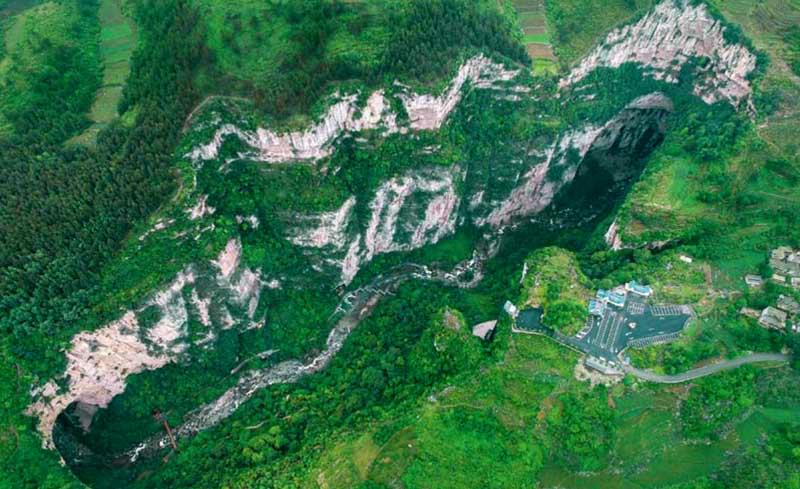Seeing Green
2016-10-25byWanXiubin
by+Wan+Xiubin
On July 8, 2016, Guizhou Province welcomed 1,200 distinguished guests from China and overseas as well as 2,500 foreign and domestic enterprises to brainstorm conservation culture. First held in August 2009, the forum, known as Eco Forum Global, has established a platform for people from all corners of the planet to address issues concerning green development, natural conservation, and climate change. Host Guizhou Province has been making strides to open its window to the rest of the world — The New York Times cited Guizhou as one of the most worthy places to visit in 2016.
Understanding & Protecting“Green”
Summer heat is eased away by the cool breeze from the dense forest in the park of Mt. Huancui (“Green All Around”) in Zhenning County. “It used to be considered a ‘poor place with mountains and trees,”remarks Xiang Yuegui, vice magistrate of Zhenning. “But now its hard to find anywhere like that. Data attests to the success of better utilizing our naturally-endowed resources. Smartly planning around mountains and rivers not only brings great harmony to our lives, production, and ecology, but also attracts more investors.”
Zhenning is merely one of many case studies for local development in Guizhou. Over the last few years, the province has achieved impressive social and economic progress by practicing conservation culture. Between 2011 and 2015, for example, its province-wide forest coverage increased by 1 percentage point annually. By the end of 2015, forests covered 132 million mu, over half of its total area. Guizhou is home to 78 forest parks, 104 forest and wetlandbased nature reserves for wildlife, and 40 wetland parks. In 2015, the provincial government launched a three-year action plan to build 9.16 million mu of forests, which will push its green coverage to 54 percent in 2017.
“You can understand why so many people consider Guizhou a top holiday destination,” commented Christa Markwalder, president of the National Council, Swiss Parliament. “The province has impressive forests and terraced fields, well-patterned dwellings, and smart planning. Guizhou used to be isolated due to its topography, and now it is a flagship for the rest of the country in terms of ecological progress, which has become a massive driving force for its economic growth.”
Systemic Guarantees
About nine years ago, Chinas first court specializing in environmental protection was established in Qingzhen, Guiyang City of Guizhou, especially to decide the countrys first civil public welfare dispute, in which an environmental protection organization sued a paper mill over sewage discharge.
In January 2015, the verdict was delivered: The defendant was found guilty and involved local government officials were removed from office.
Today, the provincial government welcomes environmentally-friendly lawsuits and has established a specific judicial network involving its Higher Peoples Court, procuratorate, and Department of Public Security.
Alongside the legal infrastructure, Guizhou has also accelerated its green development with an appraisal mechanism. In 2014, it led the country in enacting regulations to promote conservation culture. According to regulations, GDP assessment of areas where development is restricted and key counties of national poverty alleviation will be waived, and instead, new criteria such as the proportion of circular economy and cleaner industries in gross regional product will be followed.
Governmental compensation mechanisms and the market have joined forces to enhance pollution treatment. In early 2014, the local government implemented a bilateral compensation system to protect the Chishui River region: Zunyi City, downstream, paid compensation to Bijie City, upstream, for Grade 2-plus quality water in its river section. If the water quality drops, Bijie has to pay Zunyi. Since implementation, Zunyi has paid Bijie 28 million yuan.
Win-Win Strategy
A lush oil-tea plantation spanning over 20,000 mu in Zhujiachang Town, Yuping County, was previously barren hills. “There are many hills, and they have a thin layer of soil,” illustrates villager Wu Rongshun.“We spread seeds over the hills, but harvested little. Today, after planting trees, underneath them we have seeded medicinal herbs, which are green and fruitful.”
Guizhou is rich in mountain resources. However, many attempts to reclaim hills for farming fail due to water erosion. Now, Guizhou farmers have learned to work in a more scientific way by planting cash crops, such as trees, fruits, tea, and flowers, which has in turn fueled secondary and tertiary industries in mountainous areas.
Over the last five years, Guizhous tourism income has seen an annual increase of 25 percent, and last year, tourism became a pillar industry for the province after adding 9.1 percent to its total output value.
“Weve been striving to balance protection and development,” says Chen Yiqin, deputy secretary of the Guizhou Provincial CPC Committee and secretary of the Provincial Politics and Law Committee.“Weve kept a foothold on market demand, strengthened the production capacity of eco-products, mobilized all possible resources to support the ecological development, and expanded the effective support of the eco-products. Today, our advantageous eco-resources have transformed into an everlasting source of revenue.”
In 2015, Guizhou broke its GDP record with over 1 trillion yuan and has led the country for five successive years in growth of major economic indicators. Moreover, nine cities and prefectures have met national standards for drinkable water, and 90 percent of the air quality is exceptional.
Guizhou has moved forward with the motto of “Protecting Our Green Mountains and Rivers While Making Fortune from Them.”